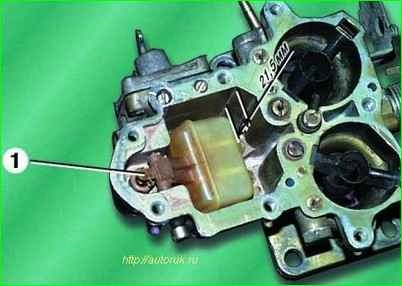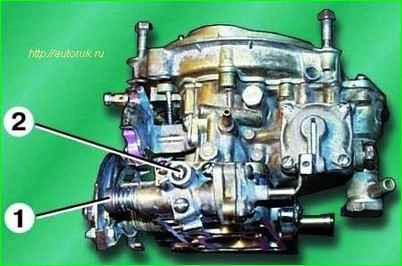The fuel level in the float chamber is adjusted with the carburetor cover removed.
However, without disconnecting the trigger rod, you can unscrew the cover mounting screws, lift it up and, after removing the gasket, turn the cover to the side as far as the gaps in the rod mounting points allow.
Pump gasoline into the float chamber using the manual fuel pump lever until the level stabilizes.

The distance from the fuel level to the upper plane of the carburetor body should be 21.5 mm.
If the fuel level is below the specified level, it is necessary to bend up the tongue 1 of the float, which rests against the tail of the shut-off valve needle.
If the level is high, bend the tongue down.
After each bend of the tongue, unscrew the drain plug of the float chamber, drain the gasoline from it and, having screwed the plug back in place, re-pump the gasoline using the manual fuel pump lever.
You can adjust the starting system directly on the car, having completely warmed up the engine and connected a tachometer to it.
After starting the engine with the air filter removed and lightly pressing the accelerator pedal, completely close the air damper with its drive handle.
Then use a screwdriver blade to open the air damper as much as the lever mechanism will allow.
The engine crankshaft speed should be 2500-2700 min-1.
If it differs from the specified one, you need to loosen the lock nut on the adjusting screw resting against the profile lever and screw this screw in or out.
After completing the adjustment, tighten the lock nut tightly.

Fig. 2. Adjusting the carburetor fuel mixture: 1 - fuel mixture quantity screw; 2 - fuel mixture quality screw
Adjust the idle system on a warm engine with a tachometer connected to it.
To do this, set the quality screw 2 on a running engine to the position that ensures maximum idle speed.
Then, using the quantity screw 1, set the speed increased by 100-120 min.
After this, tighten the quality screw until the speed decreases by 100-120 min.
This adjustment method allows you to meet the exhaust toxicity standards.
However, it is recommended to carry out more precise adjustment using a gas analyzer.





